

Click on the picture on the left below to see a larger version. Use the "back" button on your browser to return to this page.
In the right-hand column is a picture of the whole Moon (at about the same phase) indicating where the feature is situated.
Lunar Features and Notes
Here I discuss briefly the different features on the Moon and how they may have been formed. I also
cover the modern conventions of which way is up, and which way is West, and indicate my sources of information.
I have made every effort to be accurate but please be aware that I am not infallible and bring to my attention any
errors you may find. I will attempt to correct them speedily.
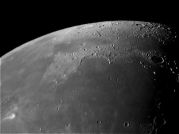
Two pictures show much of the north-west quadrant of the Moon, the Mare Imbrium and various features to the north.
They wwre taken with a ToUcam attached to my LX200 with a 0.33 focal reducer on 16th December 2003, when the Moon was 21.6 days old, and 16th November 2005, when the Moon was 11.5 days old.
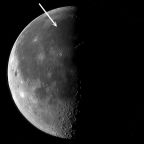
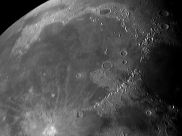
This is the Mare Imbrium (the Sea of Showers), the largest and youngest
impact basin on the visible face of the Moon.
The picture was taken with a ToUcam attached to my LX200 with a 0.33 focal reducer when the Moon was 20.1 days old.
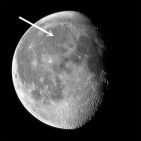

This is a mosaic of the north polar region of the Moon. The libration was favourable so the north pole itself is in the image.
It was taken with a ToUcam attached to my LX200 on 16th September 2005 at 20:45 UT,
when the Moon was 13.4 days old.
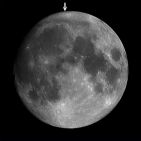
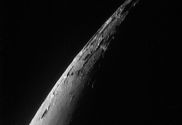
Clicking on this image will take you to a page showing eight pictures
taken on the same night when the Moon was 26.3 days old.
They were taken with a ToUcam attached to my LX200 on 31st August 2005 between 04:14 and 04:40 UT,
when the Moon was 26.3 days old.
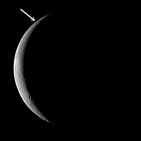
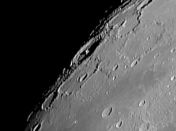
Pythagoras is a large crater in the far north-west and is close to Babbage.
The picture was taken with a ToUcam attached to my LX200 on 11th May 2005 at 00:24 UT,
when the Moon was 12.5 days old.
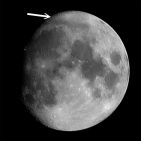
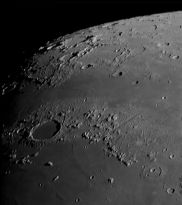
A closer view of the area from Plato to the north pole seen with the worst
possible libration.
This picture was taken with a ToUcam attached to my 254mm LX200 on 5st March 2005,
when the Moon was 9.1 days old. 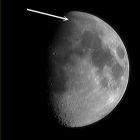
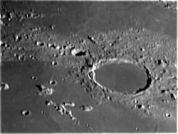
Plato is a large, circular feature 104 Km in diameter. It is some 3,500 million years old and is situated
on the northern edge of the Mare Imbrium. It has a very flat floor which contains many very small craters only a few of which
are visible in this image.
This picture was taken with a ToUcam attached to my 254mm LX200 with a X2 adaptor lens on 1st March 2004, a night of exceptional seeing,
when the Moon was 9.7 days old. 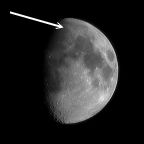
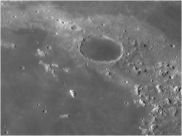
Mount Pico is an interesting, isolated mountain in Mare Imbrium. It was almost certainly left sticking up
as Mare Imbrium flooded with lava some 3,800 million years ago. The "island" is 26 Km across and rises
to a height of 2,400 metres, and is situated some 130 Km south of the crater Plato.
The picture was taken with a ToUcam attached to my ETX125 with a X2 lens attached on 4th September 2004,
when the Moon was 19.9 days old.
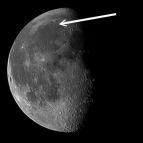
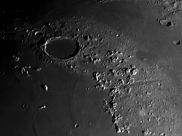
The Lunar Alps are a comparitively small mountain chain representing the north-east boundary of the mare Imbrium.
This picture was taken with a ToUcam attached to my LX200 on 10th December 2005, when the Moon was 9.8 days old. The page also contains a picture taken in January 2002 when the Moon was
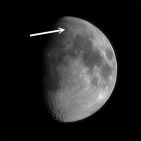
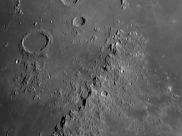
These are the Apennine Mountains which mark the south-eastern boarder of
Mare Imbrium, and it was in the north of this range where Apollo 15 landed close to Hadley Rille.
The picture was taken with a ToUcam attached to my LX200 on 5th March 2005,
when the Moon was 9.1 days old. 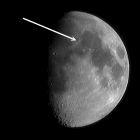
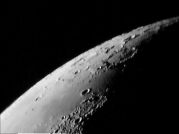
This is the north-western limb of the Moon. These areas are difficult to image well. Not only are the features
foreshortened by perspective, so are the shadows and the lighting is never right. At full Moon the light is coming from behind
the camera, so we don't see the shadows that are there. Here we see the area at sunset, but the light is coming towards the camera
and reflections make the surface bright.
The picture was taken with a ToUcam attached to my ETX125 on 24th August 2003, when the Moon was 24.9 days old.
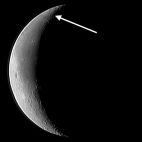
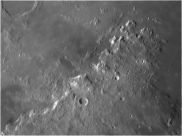
These are the Lunar Apennine Mountains, south-east of the crater Archimedes.
I have managed to capture Hadley Rille, visited in 1971 by the Apollo 15 astronauts. The rille is about
1.5 Km wide and about 300 metres deep. Its proximity to the mountains demanded great precision in navigation
of the lunar lander.
The picture was taken with a ToUcam attached to my ETX125 with a X2 lens attached on 4th September 2004,
when the Moon was 19.9 days old.
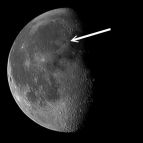
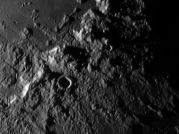
In this closer view of the Apennine Mountains, the Hadley Rille
is clearly seen at the top of the picture. The mountains mark the south-eastern wall of the Mare Imbrium,
and are almost 1000 Km long and about 100 Km wide. They rise to a height of 5400 metres.
The picture was taken with a ToUcam attached to my LX200 with a X2 adaptor lens on 6th September 2004
when the Moon was 21.8 days old.

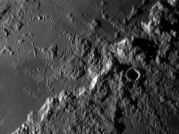
This area is just a little south of the area shown above and shows the whole of the Bradley Rille.
Hadley Rille is just visible at the top of the picture which also shows a part of Conon Rille at the bottom.
The picture was taken with a ToUcam attached to my LX200 with a X2 adaptor lens on 6th September 2004
when the Moon was 21.8 days old.

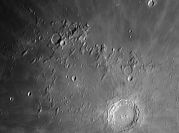
These are the Carpathian Mountains which represent the south-western edge of the Imbrium basin.
The picture was taken with a ToUcam attached to my LX200 on 12th November 2005
when the Moon was 11.4 days old.
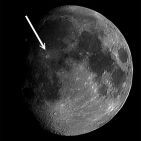
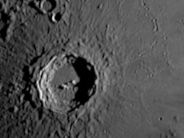
Copernicus is a very young crater at less than 1,000 million years. It is 95 Km in diameter
and its walls rise to 3,760 metres. It has three central mountains, the highest 1,200 metres
high. The northern part of the floor is significantly smoother than the southern part.
Mare Imbrium is to the north, Mare Nubium to the south.
The pictures were taken with a ToUcam attached to my ETX125 with a X2 lens attached
when the Moon was 9.1 days old and with my LX200 with the X2 lens when the Moon was 22.8 days old.
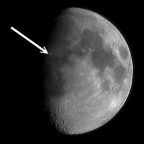
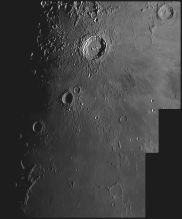
A mosaic of three pictures of the area south of Eratosthenes and Copernicus as far south
as Fra Mauro.
The pictures were taken with a ToUcam attached to my LX200 when the Moon was 10.0 days old.
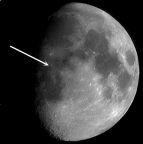
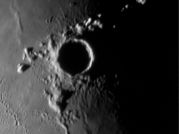
Eratosthenes is 60 Km in diameter and slightly older than Copernicus, to its south-west, at between 1,000
and 3,000 million years. It lies on the southern end of the Apennine mountains and is some 3,600 metres deep.
The picture was taken with a ToUcam attached to my LX200 with a X2 lens attached when the Moon was 22.8 days old.
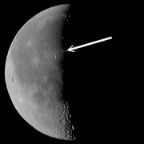
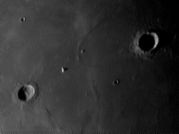
This is a fairly featureless area of central Mare Inbrium. Lambert and Timocharis are the main
craters here. They are both about 35 Km in diameter and 2700 metres deep. The two smaller craters are
9 Km in diameter and 1400 metres deep.
The picture was taken with a ToUcam attached to my LX200 with a X2 lens attached when the Moon was 22.8 days old.
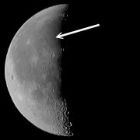
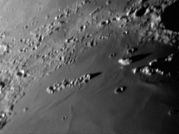
This is the northern part of the Mare Imbrium. The feature in the centre of the picture is the Montes Recti,
or Linear Mountains. The mountains to the north are the Jura.
The picture was taken with a ToUcam attached to my LX200 with a X2 lens attached when the Moon was 22.8 days old.
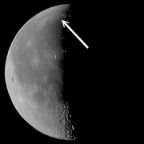
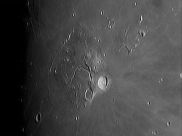
Schröter's Valley is a long sinuous rille some 165 Km long and mostly between 6 and 10 Km wide.
It begins, about 25 Km north of the crater Herodotus, with an elongated crater called "The Head of the Cobra"
and winds north before veering to the west. Herodotus itself is 36 Km in diameter and 1400 metres deep with a flat,
lava-filled floor. The most prominent crater here is Aristachus, 41 Km in diameter and 3000 metres deep.
It is a very youg feature at only 450 million years, compared to more than 3,000 million years for Herodotus and
Schröter's Valley.
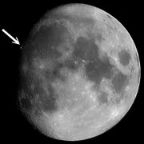
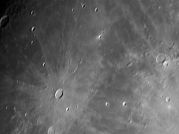
Kepler is a recent formation about 550 Km south of Aristachus in the picture above. Kepler is 32 Km in diameter and 2750 metres deep and is surrounded by the Oceanus Procellarum.
The picture was taken with a ToUcam attached to my LX200 when the Moon was 12.6 days old.
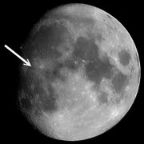
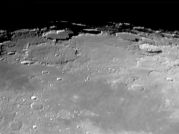
J Herschel was named after John Herschel, son of the more famous William Herschel who discovered Uranus.
His crater, at 160 Km in diameter, is almost four times the size of the crater named after his father (a mere 43 Km
in diameter).
The picture was taken with a ToUcam attached to my LX200 when the Moon was 12.6 days old.
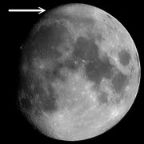
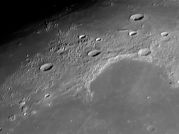
The Sinus Iridum is a bay off the Mare Imbrium and is bounded to the north by the Jura Mountains. It
measures some 410 by 265 Km and covers an area of 237,000 square kilometres.
The picture was taken with a ToUcam attached to my LX200 when the Moon was 12.6 days old.
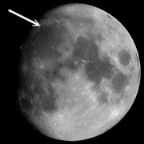
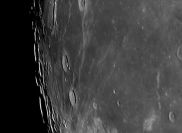
The western part of the Oceanus Procellarum showing Krafft, Cardanus, and Catena Krafft as well as
several craters named after well-known scientists and an explorer.
The picture was taken with a ToUcam attached to my LX200 when the Moon was 13.9 days old.
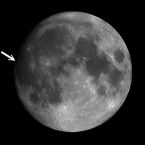
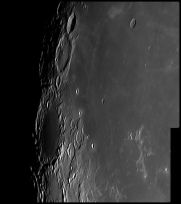
This picture is to the south of the picture above and taken at about the same lunation, but there is not enough overlap to try to join them together.
The picture was taken with a ToUcam attached to my LX200 when the Moon was 13.4 days old.
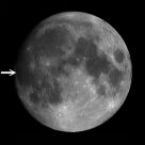
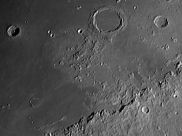
Montes Archimedes are a small range of hills south of the crater Archimedes.
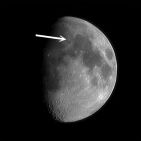
Home Back to the Moon